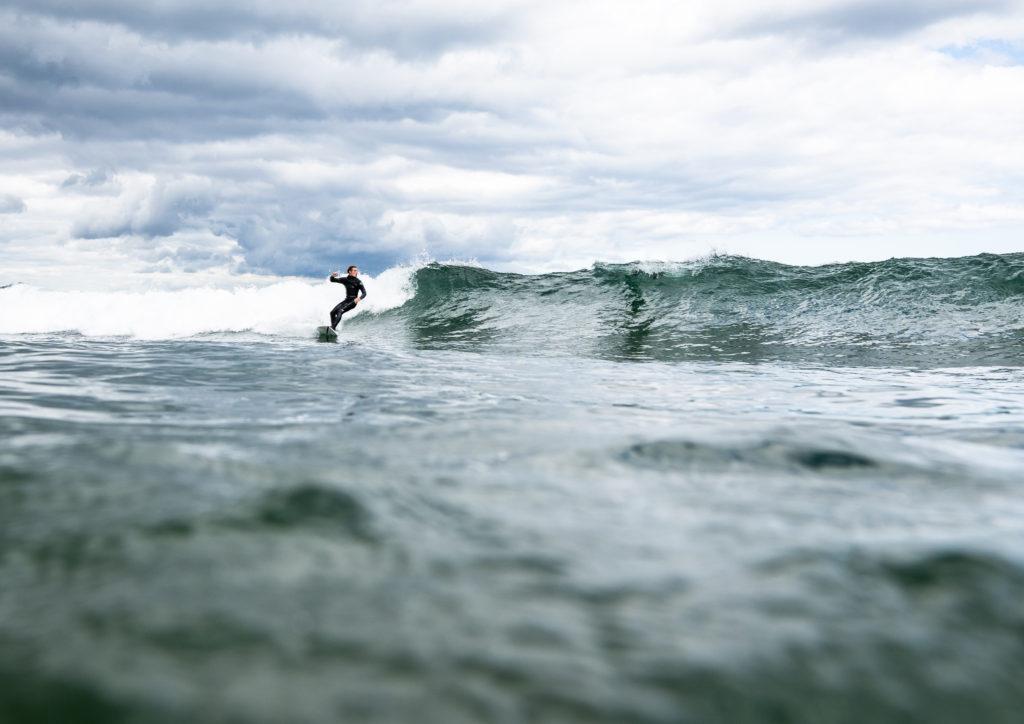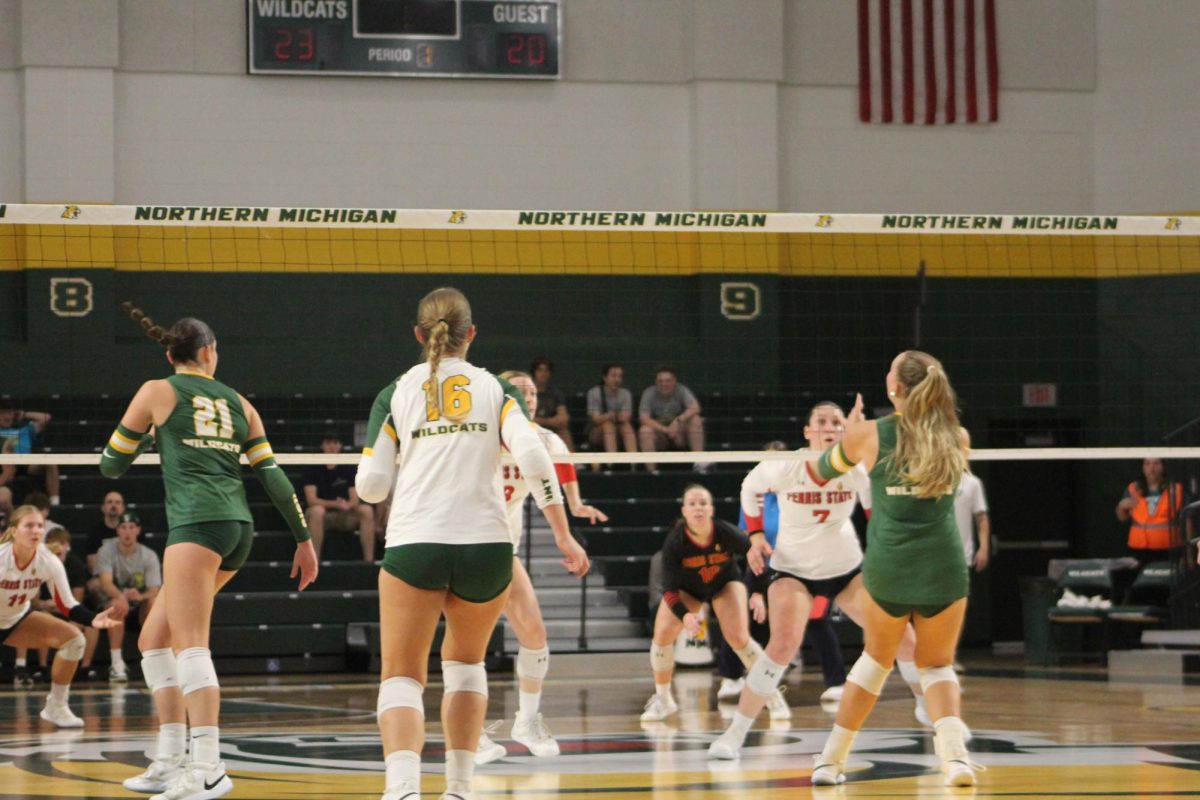Once the Indian summer sun finally sets and beach days come to an end, hurricane gales shortly take over on Lake Superior. Some people scavenge inside their homes to dive under the flannel-themed covers for warmth, away from the hazardous turmoil thrashing outside. But some like NMU student Elliot Kennedy suit up in wetsuits, gloves and boots and grab their 6-foot surfboards to mount upon Superior’s turbulent crests.
Surfing is hot in a cold territory like Marquette. What started out as just a few people floating on their boards at McCarty’s Cove has flooded into the Marquette community, attracting crowds of surfers on some of the stormiest U.P. days.
“There’s something about it when you’re out there that just makes you feel connected to nature and the outdoors because you are floating and bobbing up and down with the water,” Kennedy, junior digital cinema major and marketing minor said. “Waves are waves, and they’re beautiful, and people have found a way to use them to our benefit. There’s no purpose to it other than it makes your soul feel good.”
Typical surfing conditions in Marquette usually require strong winds and this happens between October and March, where the more volatile weather brings forth wave-producing low-pressure systems. Surfable waves can reach 10 to 12 feet high, but most waves generate a height of 6 to 8 feet, according to Down Wind Sports’ website.
Kennedy, along with junior nursing major Chloe Gagern and community member and seasoned surfer Tyler Hellner, ride Superior’s waves any time the waves are large and consistent. But like with many other activities in the U.P., it all relies on the weather.
Waves have to constantly be breaking, Kennedy said, who will swim out past the breaks to see where the best waves are located. Then he’ll paddle in while a big wave approaches and lay down on his board. It’s all about fate, Kennedy said, sometimes you catch them and sometimes you’re flipped under the water.
“If you do [catch it], you ride for five to 15 seconds and it’s amazing,” Kennedy said. “You can catch one wave in session of two hours, and it will be so worth it.”
Anytime the waves are calling, Kennedy is out there, he said, adding, he even went one time at 7 a.m. before his 9 a.m. class. Even if he’s just riding the waves, he lives for any moment to be in the water, Kennedy said.
“One thing about Lake Superior surfing is it’s more about the adventure than the waves,” he said. “I’ve probably caught five in a row ever. But I love it.”
Marquette surfers usually go to “The Zoo,” which refers to the rocky shore at Presque Isle, mainly because it has the best conditions for surfing, Hellner said. This hot surfing spot is located upon entering the park, where people turn left, drive until Middle Bay and park at the Lake Superior Watershed house. The 29-year-old from Stevensville, Michigan, said the rocks break up the waves in certain spots and surfers need to paddle far enough out in the water without being thrashed by incoming waves.
For 11 years, Hellner has ridden waves from the Great Lakes, the Atlantic Ocean to the north shore of France. But Hellner said he prefers Superior.
“I have a weird relationship with Lake Superior because Lake Michigan is a big softy, it doesn’t seem like you’ll die. But Lake Superior scares me a little bit. It’s always cold no matter what, you can still die of hypothermia anytime of the year,” Hellner said. “[But] it’s the best lake to surf on, because it’s so deep, cold and big.”
Fall is probably the best time to grab the paddle board, Hellner said. The colder water temperatures and strong autumn winds create the best crests and it’s much more difficult surfing in the U.P. than it is anywhere else, he said.
“It’s a really good workout and it’s a lot of fun. It’s a unique experience to just be picked up by something; it’s an infectious feeling,” Hellner said.
The “Widow Maker”—a big boulder the size of a car—is a surf-board breaker at The Zoo, surfers should be aware of, Kennedy said, adding, it’s important for anyone who’s not as experienced surfing on Lake Superior, understand the conditions and all the other rocks out in the lake.
“You can watch videos all the time, go out on calm days, paddle around and get strong but nothing compares to being in it when it gets like that,” he added. “It’s overwhelming sometimes, getting hit by freezing cold water.”
Gagern said she uses the website MagicSeaweed.com, which gives a surf forecast, along with monitoring the water through the Great Lakes Conservation Corps’ web cams. The best days to surf are usually the worst days, and it’s vital you’re a strong swimmer, Gagern continued. Though Gagern trained as a surfer in British Columbia two years ago, catching a wave on Superior is an ultimate test, and not a joke, she said.
When Gagern transferred from Grand Valley State University last semester, she wanted to get right back into surfing. And this past spring, Gagern went out to The Zoo and jumped out from the rocks and all she could think was, “I shouldn’t be here.”
Even though it can be dangerous, there’s a stress-relieving nature to it, she added.
“I think it’s the wild aspect of it I enjoy most. The weather is like crap and usually people are inside being all cozy and there’s us, jumping in the water. It’s gray and scary, and I’ve got my mittens and boots on, and I feel a little ridiculous, but here I am,” Gagern said.
When other students are cozied up inside complaining about the treacherous weather, there are those who surf and take advantage of the 30 mph winds, Kennedy said.
“If there’s waves, I’ll probably skip work if I can or not do homework,” Kennedy said with a sly chuckle. “If I could go surfing every day, I would.”





























